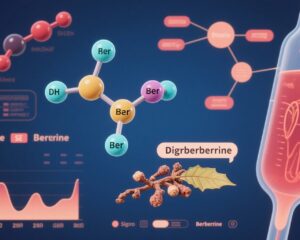Highlights
- Dihydroberberine exhibits significantly faster and greater bioavailability than berberine in humans, enabling potentially enhanced pharmacological effects.
- Recent integrative metabolomic and network pharmacology studies identify dihydroberberine among key bioactive alkaloids contributing to anti-inflammatory and metabolic regulatory effects.
- Mechanistic pathways involving PI3K-Akt, MAPK, and calcium signaling underpin the therapeutic actions, paralleling those elucidated for berberine.
- Promising clinical applications for dihydroberberine include metabolic syndrome, type 2 diabetes mellitus, and inflammatory conditions such as asthma.
Background
Berberine, a plant-derived isoquinoline alkaloid, has been widely investigated for its therapeutic effects in metabolic disorders including type 2 diabetes mellitus (T2DM), dyslipidemia, and inflammatory diseases. However, its clinical utility is limited by poor oral bioavailability, necessitating high doses that may cause gastrointestinal side effects.
Dihydroberberine is the reduced form of berberine and has gained attention over the past five years for its capacity to overcome berberine’s absorption limitations. Enhanced pharmacokinetic profiles suggest dihydroberberine as a promising candidate to potentiate berberine’s diverse pharmacodynamic effects. This review integrates findings from the latest PubMed literature to outline the absorption kinetics, molecular mechanisms, and translational potential of dihydroberberine, highlighting relevant diseases for clinical application.
Key Content
Absorption and Pharmacokinetics of Dihydroberberine
A pivotal randomized, controlled, crossover pilot trial (PMID: 35010998, Nutrients 2021) assessed plasma berberine levels following oral doses of berberine versus dihydroberberine in healthy volunteers. The study demonstrated that oral dihydroberberine (100 mg and 200 mg) produced significantly higher peak plasma concentrations (CMax) and area under the curve (AUC) for berberine than 500 mg of berberine itself, with CMax for 100 mg dihydroberberine at approximately 3.76 ng/mL compared to 0.4 ng/mL for berberine. This implies a much faster and more efficient absorption and biotransformation of dihydroberberine to berberine in vivo, potentially enabling lower dosing with improved tolerability.
No acute effects on glucose or insulin levels were observed in the short-term study among healthy individuals, which underscores the need for longer-term trials targeting insulin-resistant or glucose-intolerant populations to detect potential efficacy.
Molecular Mechanisms and Pharmacodynamics Inferred from Berberine
Berberine exerts its effects via multiple biochemical pathways including activation of AMP-activated protein kinase (AMPK), modulation of PI3K-Akt signaling, MAPK pathways, and Ca2+ signaling, influencing glucose and lipid metabolism, mitochondrial function, and inflammatory cascades. Given the metabolic conversion of dihydroberberine to berberine, it is plausible that these molecular pathways mediate dihydroberberine’s biological activity as well.
A 2022 study applying metabolomics and network pharmacology to asthma treatment with a multi-component therapy identified dihydroberberine as one of several bioactive alkaloids targeting serum creatinine kinase (SRC), MMP-9, and related protein targets, implicating modulation of the PI3K-Akt, MAPK, and calcium signaling pathways in anti-inflammatory mechanisms (PMID: 36604927). This supports dihydroberberine’s relevance not only in metabolic but also in inflammatory disease contexts.
Potential Clinical Applications and Therapeutic Areas
Based on berberine’s extensive evidence base and enhanced plasma exposure of dihydroberberine, the latter could have therapeutic potential in:
- Metabolic Diseases: T2DM, insulin resistance, dyslipidemia, and metabolic syndrome through improved glucose homeostasis and lipid profile modulation.
- Inflammatory Diseases: Conditions such as asthma, where dihydroberberine modulates key signaling pathways involved in airway inflammation, as suggested by network pharmacology analyses.
- Cardiovascular Risk: Through endothelial function improvement and anti-inflammatory effects, as demonstrated in berberine studies.
- Neuroprotection and Gut Microbiota Modulation: Emerging evidence for berberine implicates neuronal and microbiota-mediated benefits, which may extend to dihydroberberine given its improved systemic availability.
Expert Commentary
Recent advances confirm dihydroberberine’s superior absorption kinetics as a key advantage over berberine, addressing a critical pharmacological limitation. While preliminary human trials indicate enhanced plasma berberine levels post-oral dihydroberberine, clinical efficacy on glycemic control and other endpoints remains to be validated in populations with metabolic disease.
Mechanistic insights derived from berberine’s well-characterized pathways provide a strong biological rationale for dihydroberberine’s therapeutic effects. The involvement of PI3K-Akt and MAPK pathways aligns with the cellular signaling nodes implicated in insulin sensitivity, inflammation, and cellular metabolism. Detection of dihydroberberine among bioactive ingredients in complex traditional medicine formulations targeting asthma further expands its potential role beyond metabolism.
A notable limitation is the paucity of large-scale randomized clinical trials directly assessing dihydroberberine’s therapeutic efficacy and long-term safety. Additionally, variability in dosing, formulation, and conversion efficiency merits further pharmacokinetic/pharmacodynamic research.
Clinicians and researchers should consider dihydroberberine as a next-generation alkaloid nutraceutical or pharmacological candidate, particularly for metabolic and inflammatory conditions where berberine’s benefits are recognized but constrained by bioavailability.
Conclusion
Over the past five years, dihydroberberine has emerged as a promising derivative of berberine with markedly enhanced oral absorption and plasma availability. Mechanistically linked to berberine’s multifaceted metabolic and anti-inflammatory effects, dihydroberberine holds potential for improved clinical efficacy with reduced dosing and side effects.
Future research priorities include rigorous clinical trials in metabolic syndrome, T2DM, and inflammatory diseases such as asthma to confirm therapeutic benefits and clarify safety profiles. Understanding the precise molecular interactions in human disease contexts will facilitate therapeutic optimization. With these advances, dihydroberberine could become a valuable adjunct or alternative in managing prevalent chronic diseases where berberine is currently limited by pharmacokinetic factors.
References
- Thompson K et al. Absorption kinetics of berberine and dihydroberberine and their impact on glycemia: a randomized, controlled, crossover pilot trial. Nutrients. 2021;14(1):124. doi:10.3390/nu14010124. PMID: 35010998.
- Wei X et al. Anti-asthma components and mechanism of Kechuanting acupoint application therapy: based on serum metabolomics and network pharmacology. Zhongguo Zhong Yao Za Zhi. 2022;47(24):6780-6793. doi:10.19540/j.cnki.cjcmm.20220614.501. PMID: 36604927.



